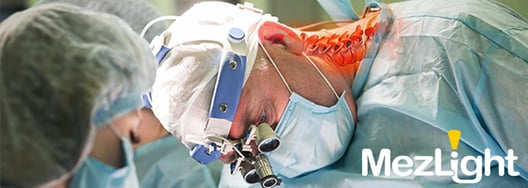
Ask any surgeon, and they'll tell you about how grueling surgery can be. It's an endurance sport that is not only exhausting but can also be painful during and after performing procedures on patients. One of our co-founders, transplant surgeon Dr. Josh Mezrich, has been working through the pain for years, which is why he invented MezLight. But he’s not alone.
A JAMA study from 2018 helped shine a light on how prevalent Musculoskeletal Disorders (MSDs) are amongst surgeons. The results were aggregated from dozens of studies performed in 23 countries over the last 30 years and revealed some concerning statistics. The article refers to these work-related MSDs as an “impending epidemic” and after reviewing the statistics, we can see why.
- Over 80% of physicians experience significant pain when performing surgery.
- 17% of surgeons have been diagnosed with degenerative cervical spine disease (c-spine disease) – the number could be higher, since many go undiagnosed.
- 12% of surgeons required a leave of absence, practice restrictions or early retirement.
Most people may not realize how physically demanding performing surgery can be. When compared to other jobs that are more commonly associated with being hard on the body, surgeons far exceed many of those occupations. For example, surgeons experience more musculoskeletal pain in the neck, shoulder and back than construction workers.
Where does the pain come from?
On the surface, performing surgery may not seem like an activity that could wear on a physician’s body, but clearly it is. The JAMA study attributes MSDs in surgeons to holdingunnatural positions for long periods of time and poorly designed instruments.
Dr. Mezrich has explained that a major contributing factor to his pain comes from his past use of headlights. Like other surgeons, he would have to situate his head in an awkward position to properly and effectively illuminate his surgical site. For procedures that last several hours, locking into an unnatural position while wearing a cumbersome headlamp can be very damaging to a surgeon’s physical well-being. In fact, 50% of surgeons believe that headlights contribute to c-spine disorders.*
The Impact of MSDs.
When surgeons are dealing with neck, back and shoulder pain, the impact is often much greater than fighting through discomfort in the OR. The ramifications can be career-altering or, in some cases, career-ending.
MSDs are chronic and the ripple effect of managing them can be felt by everyone involved with surgery. The pain isn’t just limited to the OR. Surgeons spend a lot of their time off recovering, which takes away from time spent with their families and pursuing other activities. And if the pain becomes too severe or lingers for too long, it may require that they take time off.
Some surgeons have addressed their MSDs by paring down the number of procedures they’ll perform. Others have gone further by opting to retire from surgery as opposed to enduring through the pain. One physician we spoke to even attributed his three cervical spine fusion surgeries to the years spent working with headlights in the OR.
“Any time you have a headlight on, your gaze is relatively fixed. You don’t wind up with natural head or neck motion.”
Dr. Ash Anderson // Chief Medical Officer – Promega Corporation
What’s the fix?
The JAMA study identified a troubling trend in the prevalence of MSDs. Since they examined research dating back to 1974, they concluded that the problem is getting worse and a workforce shortage is expected by 2025. However, they also recognized a couple of ways to help reverse the trend – better education and better instruments.
When asked about ergonomics training and education, it was found that surgeons lacked access to helpful information throughout their career. Medical schools haven’t done a good enough job teaching ergonomically-friendly practices, hospitals don’t promote healthier techniques and surgeons themselves don’t seek out more pain-free ways to operate – everyone’s at fault. We hope to see more surgeons embrace the training and information that is available, which may help extend careers and support better patient outcomes.
The study also shined a light on better instrumentation as another solution to help avoid and manage MSDs. From supportive furniture, to repositioned video, to headlight alternatives, devices and medical technology that help promote ergonomics in the OR can play a large role in keeping surgeons active.
MezLight’s Mission to Help Reduce MSDs
Dr. Mezrich knows that using a MezLight will contribute to a longer, less painful career for he and his wife, vascular surgeon Dr. Gretchen Schwarze. Our product takes the light off of surgeons’ heads, which can benefit them in multiple ways.
- Less weight to be supported by physicians’ necks, backs and shoulders.
- More freedom to move their heads and stretch, without compromising the position of their light source.
- An easily positioned instrument that gives them more control over the procedure.
Our goal is for surgeons and hospitals to move away from the way surgical lighting has always been done, and to adopt the use of a MezLight in the OR. Based on what we learned from the JAMA study, we believe that it will have a positive impact on the well-being of surgeons, which can help lead to better patient outcomes. It’s a win-win.
If you’d like to learn more about MezLight, we’d be happy to chat. We look forward to helping make your time in and out of the OR more comfortable.
*Female Pelvic Medicine & Reconstructive Surgery: January/February 2018 - Volume 24 - Issue 1 - p 1–12


